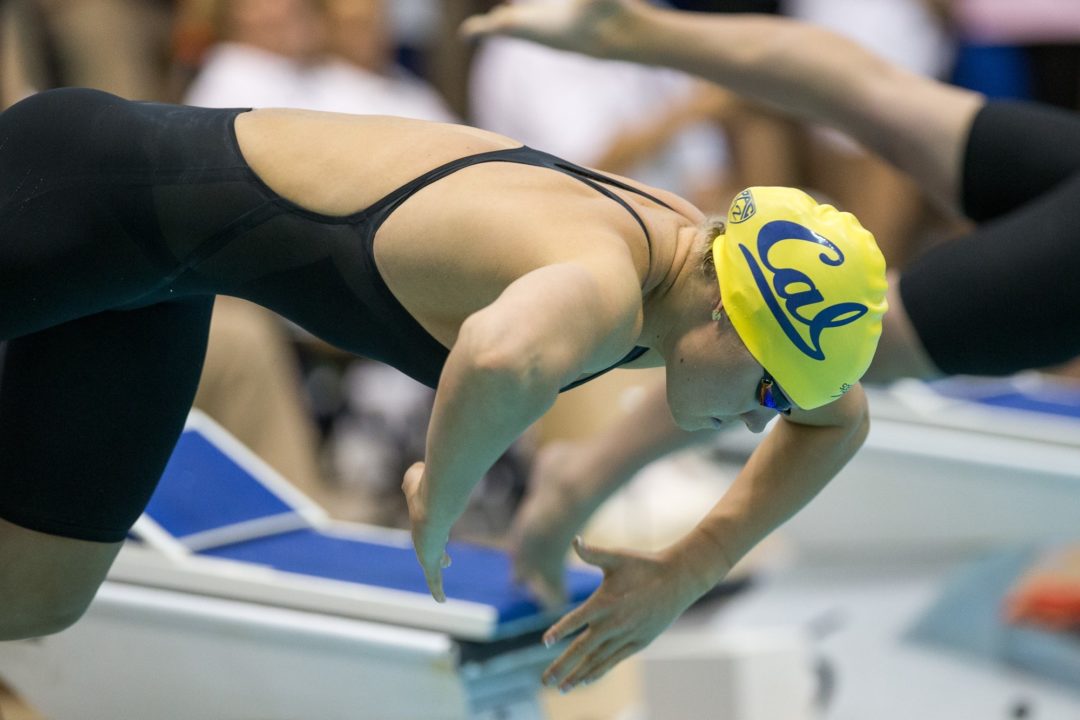Editor’s Note: SwimSwam is not on the voting panel for the CSCAA Dual Meet Rankings, but are posted as a courtesy. See our most recent women’s Power Rankings here.
The California Golden Bears have launched to the top of latest College Swimming Coaches Association of America poll, riding a big weekend at the Georgia Invite to rise from 5th in the last set of rankings.
They pass up previous leaders Texas A&M, who dropped down to 4th, their finishing spot at last year’s NCAA Championships. The top 3 ranked teams are now the top three finishers from a year ago – defending NCAA champs Georgia remain second after their home invite, while 2014 NCAA runners-up Stanford are still ranked third a few weeks after their mid-season rest meet in College Station.
Biggest risers: Florida (+9), UCLA (+9), Louisville (+8)
Biggest fallers: North Carolina (-9), Auburn (-7)
Press release courtesy of the College Swimming Coaches Association of America:
CSCAA NCAA Division I Women’s Swimming and Diving Team Ranking Supported by TYR
The College Swimming Coaches Association of America (CSCAA) Division I Team Rankings are compiled by nine CSCAA-member coaches and one media member. The rankings will be released on a weekly basis throughout the 2014-15 season, alternating weeks between a men’s and women’s team ranking.
The CSCAA DI Poll Committee will produce in-season rankings of the 25 best performing NCAA Division I Swimming and Diving teams in rank order at the time of each poll. The poll is not designed to predict the results of the NCAA Championship, but rather which teams would win head-to-head against other teams in the country. Ranking are based on performances that have taken place since the previous poll and include invites as well as dual meets.
CSCAA NCAA Division I Women’s Swimming and Diving Ranking as of December 10, 2014
- California
- Georgia
- Stanford
- Texas A&M
- Virginia
- Texas
- Florida
- Michigan
- Louisville
- UCLA
- Tennessee
- Minnesota
- Auburn
- Arizona
- Indiana
- Missouri
- Penn State
- Southern California
- Purdue
- Florida State
- Louisiana State
- Wisconsin
- North Carolina
- Boise State
- Kentucky
Also receiving votes: Alabama, Arkansas, Iowa, North Carolina State, Ohio State, Southern Methodist, Virginia Tech
A NCAA Division I Women’s Swimming and Diving Team Ranking Committee
Chair: Matt Barany, University of Richmond; Dan Colella, Duke University; Roric Fink, University of Texas; Naya Higashijima, UCLA; Kristin Hill, Boise State University; Sue Novitsky, University of Illinois; Katie Robinson, Tulane; Brian Smith, University of Georgia; Suzanne Yee, Princeton University; Jeff Commings, Swimming World Magazine

The Cal women swam well and are certainly worthy of the number one ranking. However, they went from 5 to 1 jumping past Georgia when the lady bulldogs actually won the meet. The reality is that these rankings and most in season meets have little real value. Are swimmers getting “A” standard swims and qualifying for NCAA’s is more informative. Most of the swimmers that will score points in March won’t swim tapered until February or many in March, which is why the NCAA’s are such a wonderful and wide open event. It just seems a little odd that the week they move to #1 comes after a meet in which they didn’t finish #1
because they brought significantly fewer people to the meet, and they’re top performers outperformed UGA’s top performers..
The rankings I assume just take into account the times done so far, not taking into account that some teams are fully rested, tapered and suited up while other teams are not.
That’s true. The only rankings that really matter are at either the conference meet (for some), and for others at NCAAs.
Since the regular season in swimming doesn’t really mean anything if you really think about it. And the rankings are just supposed to reflect the times teams have done up til that point, why do we have a ranking system in the first place? Can anyone answer that?
The Dual Meet Rankings are a little bit deceiving since everyone just swam in Invitational meets. It might make more sense to change the name to something else.